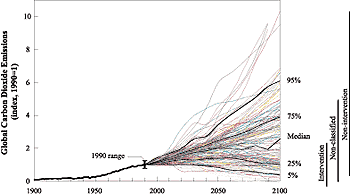1.7. SRES Emissions Scenarios
|

Figure 1-3: Global energy-related
and industrial CO2 emissions - historical development and future scenarios,
shown as an index (1990 = 1). The median (50th), the 5th, 25th,75th
and 95th percentiles of the frequency distribution are shown. The statistics
associated with scenarios from the literature do not imply probability
of occurrence (e.g., the frequency distribution of the scenarios may
be influenced by the use of IS92a as a reference for many subsequent
studies). The emissions paths indicate a wide range of future emissions.
The range is also large in the base year 1990 and is indicated by an
"error" bar. To separate the variation due to base-year specification
from different future paths, emissions are indexed for the year 1990,
when actual global energy-related and industrial CO2 emissions were
about 6 GtC. The coverage of CO2 emissions sources may vary across
the 256 different scenarios from the database included in the figure.
The scenario samples used vary across the time steps (for 1990 256 scenarios,
for 2020 and 2030 247, for 2050 220, and for 2100 190 scenarios). Also
shown, as vertical bars on the right of the figure, are the ranges of
emissions in 2100 for scenarios from the literature that apparently
include additional climate initiatives (designated as "intervention"
scenarios emissions range), those that do not ("non-intervention"),
and those that cannot be assigned to either of these two categories
("non-classified"). This classification is based on the subjective evaluation
of the scenarios in the database by the members of the writing team
and is explained in Chapter 2. Data sources: Morita
and Lee, 1998a, 1998b; Nakicenovic et al., 1998.
|
1.7.1. Literature Review and Analysis
The first step in formulation of the SRES emissions scenarios was to review
both the published scenario literature and the development of the scenario database
accessible through the web site (www-cger.nies.go.jp/cger-e/db/ipcc.html).
Chapters 2 and 3 give a more detailed
description of the literature review and analysis. Figure 1-3
shows the global energy-related CO2 emission paths from the database as "spaghetti"
curves for the period to 2100 against the background of the historical emissions
from 1900 to 1990. These curves are plotted against an index on the vertical
axis rather than as absolute values because of the large differences and discrepancies
for the values assumed for the base year 1990. These sometimes arise from genuine
differences among the scenarios (e.g., different data sources, definitions)
and sometimes from different base years assumed in the analysis or in alternative
calibrations 7.
The differences among the scenarios in the specification of the base year illustrate
the large genuine scientific and data uncertainty that surrounds emissions and
their main driving forces captured in the scenarios. The literature includes
scenarios with additional climate polices, which are sometimes referred to as
mitigation or intervention scenarios. There are many ambiguities associated
with the classification of emissions scenarios into those that include additional
climate initiatives and those that do not. Many cannot be classified in this
way on basis of the information available from the database. Figure
1-3 indicates the ranges of emissions in 2100 from scenarios that apparently
include additional climate initiatives (designated as intervention emissions
range), those that do not (non-intervention) and those that cannot be assigned
to either of these two categories (non-classified). This classification is based
on the subjective evaluation of the scenarios in the database by the members
of the writing team and is explained in Chapter 2. The
range of the whole sample of scenarios has significant overlap with the range
of those that cannot be classified and they share virtually the same median
(15.7 and 15.2 GtC in 2100, respectively) but the non-classified scenarios do
not cover the high part of the range. Also, the range of the scenarios that
apparently do not include climate polices (non-intervention) has considerable
overlap with the other two ranges (lower bound is higher) but with a significantly
higher median (of 21.3 GtC in 2100).
Historically, gross CO2 emissions have increased at an average rate of about
1.7% per year since 1900 (Nakicenovic et al., 1996); if that historical trend
continues global emissions would double during the next three to four decades
and increase more than sixfold by 2100. Many scenarios in the database describe
such a development. However, the range is very large around this historical
trend so that the highest scenarios envisage more than a sevenfold increase
of global emissions by 2100 as compared with 1990, while the lowest have emissions
lower than those of today. The median and the average of the scenarios lead
to about a threefold emissions increase over the same time period or to about
16 GtC. This is lower than the median of the IS92 set and is lower than the
IS92a scenario, often considered as the "central" scenario with respect to some
of its tendencies. However, the distribution of emissions is asymmetric. The
thin emissions "tail" that extends above the 95th percentile (i.e., between
the six and tenfold increase of emissions by 2100 compared to 1990) includes
only a few scenarios. The range of other emissions and the main scenario driving
forces (such as population growth, economic development and energy production,
conversion and end use) for the scenarios documented in the database is also
large and comparable to the variation of CO2 emissions. Statistics associated
with scenarios from the literature do not imply probability of occurrence or
likelihood of the scenarios. The frequency distribution of the database may
be influenced by the use of IS92a as a reference for scenario studies.
|